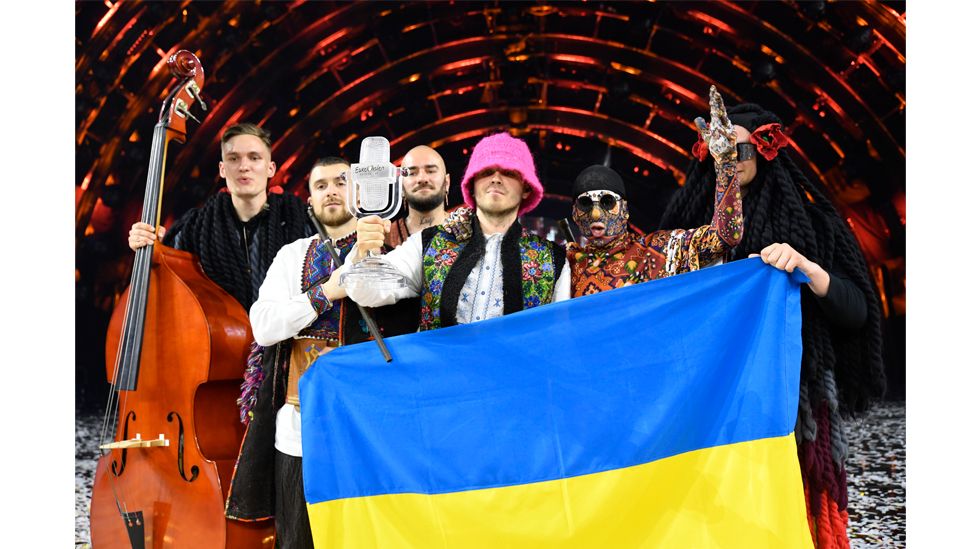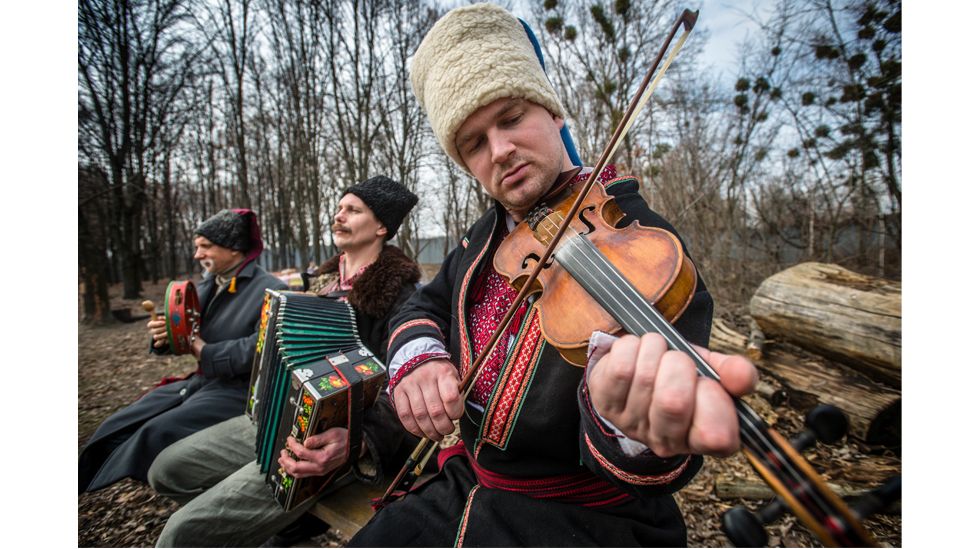From BBC Culture News,
Edited by Vinuri Randhula Silva,
(Image credit: Andrea Aray)
From Eurovision stars to Gen-Z "meme pop", musicians are determined to make a difference in Ukraine – with many of them incorporating traditional folk elements in their sound. James Jackson talks to the stars doing their bit for the war effort.
This year's Eurovision Song Contest winners, Ukraine's Kalush Orchestra, barely had time to rehearse their performance, which featured acrobatic breakdancing in traditional Vyshyvanka costumes. Instead they spent the weeks leading up to the event serving in the Ukrainian Territorial Defence Forces. Their song, Stefania, a mix of hip-hop beats and Ukrainian folk instrumentation, was the first rap and first track fully in Ukrainian ever to have won the competition. An expression of love for the lead singer's mother, the song prominently featured the sounds of two traditional Ukrainian woodwind instruments, the sopilka and the telenka.
Many international listeners' first encounter with Ukrainian music is via Eurovision, where a traditional-modern blend and epic stage performance often play well with audiences. All of the Ukrainian winners of Eurovision have integrated traditional musical elements with stories from the country's tumultuous history, while also remaining relevant. The 2016 winner, 1944 by Jamala, told the story of the deportation by Stalin of the Crimean Tatars from Crimea to Siberia, with its chorus in the Crimean Tatar language, a story that gained renewed relevance for Ukrainians when Russia annexed Crimea in 2014. The winner of the 2004 contest, Ruslana's Wild Dances, sampled trembita horns from the Carpathian mountains, and played with stereotypes about the country's "wild women" by wearing animal pelts.

The Kalush Orchestra won the Eurovision Song Contest earlier this year – their music blends traditional Ukrainian instrumentation with a contemporary sound (Credit: Getty Images)
According to Dartsya Tarkovska, co-founder of Music Export Ukraine, an organisation that promotes Ukrainian acts abroad: "Eurovision is a huge deal in Ukraine, and Ukrainians have always been big fans of the contest." It has provided major boosts for previous winners such as Ruslana and Jamala, as well as for songs that don't even win, such as 2021's epic, trance-influenced Shum by Go_A.
Pop and folk music were always close in Ukraine – pop has always included our folk identity – Tina Karol
Tina Karol, a former Eurovision contestant who is currently touring Europe to fundraise for Ukraine, tells BBC Culture: "Eurovision is so important as we can represent our country and culture, our sound. This year it was very sensitive for us to win. All our victories give us hope for winning the war." Describing this year's winning song Stefania as "really interesting" she adds, "pop and folk music were always close in Ukraine. Pop has always included our folk identity. We have different melodies and instruments than other countries – different scales for the voice, that make us very unique".
Speaking to BBC Culture on the phone, Karol points out that "since the war has started everyone is even more proud to be Ukrainian, and they are only using Ukrainian language and folk melodies. It's becoming more modern, new and popular. We want to show how beautiful our voices and melodies are. I'm really proud of our musicians. I'm sure that in the future only Ukrainian songs will exist in our country, no Russian songs."
Recently touring with Karol is Jerry Heil, a Gen-Z "meme pop" sensation – in other words, a pop singer who has become famous by incorporating snippets from viral memes from TikTok and other social media into her music and videos. Heil started out on social media, and understands the power of the internet in not only building support for Ukraine internationally, but also in keeping up morale at home.
Heil's fans agree. Comments on one YouTube video read: "I currently serve in the armed forces. Thank you for the song, from the bottom of my heart." Many of her songs have a thumbnail on YouTube, showing the blue-and-yellow flag of Ukraine and with text pointing to the stark reality of the war.
There is definitely a sisterhood – when I'm travelling, I see women who are holding together and creating something – Jerry Heil
Born Yana Shemaieva, the 26-year-old Jerry Heil wants Ukrainian music to gain international popularity in the same way that Latino music has recently. "I truly believe that Ukrainian music is the next global trend," she says. When we speak, Jerry is visiting Berlin to lead an event for Kupula night, the Slavic summer solstice. True to form, she has released a viral song #Kupala, an upbeat and catchy rap-pop remix of a Ukrainian folk song with frequent collaborator, rapper alyona alyona. They have since followed that with a collaborative EP, Dai Boh, of Ukrainian folk songs, with singers from across Europe.
Though traditionally on Kupula night in Ukraine people celebrate with the ritual of jumping over a bonfire, Jerry is using her choir-girl falsetto voice to lead a group of Ukrainian refugee women in Berlin in a sombre prayer circle in the Chapel of Reconciliation. She is travelling all around Europe in order to meet Ukrainian refugee women, and to raise funds to help rebuild their country. "There is definitely a sisterhood – when I'm travelling, I see women who are holding together and creating something. They're creating new companies already to help other Ukrainian women. When they return they will bring this newfound experience back with them."
Cultural crossover
Since the war, Heil's songs have become more political. Mriya is a rousing piano ballad with operatic harmonies about the world's biggest plane, the An-225 Mriya, which, the Ukranian foreign minister said, was destroyed by Russian soldiers in the crucial battle for Antonov airport near Kyiv. "I realised it's a strong metaphor," says the singer. "Because they can destroy the plane but they cannot destroy the dream or destroy our will."

Ukrainian pop star Jerry Heil incorporates viral snippets from social media into her music – since the war started, her songs have become more political (Credit: Andrea Araya)
It's all a far cry from when Heil first became famous. "I feel like I aged 20 years since the war started," she says. She started as a YouTuber and was a contestant on X Factor Ukraine, but her career took off when she released the catchy Okrana Otmyena (Guard, Cancel), a phrase used when returning a purchase, but used in the song about a worthless boyfriend. The phrase was already a well-known joke in Ukraine.
In Tarkovska's view, it's this eye for virality along with her new-found maturity that makes Heil "one of the key emerging pop stars. She is searching for trigger words, following memes, [and] making songs out of it. Her songs are mostly very catchy and upbeat, and by the time she releases them people already know the hook because she gets them from memes or common topics or posts clips online. Now with the war, her songs are more sad, but the idea remains the same."
Her biggest since the war started is a perfect example of this, seamlessly blending rap and pop and sampling a famous clip of a Ukrainian drag queen, Verka Serdyuchka. Heil's new song, Nesestry, was written with Vanyok Klymenko, a producer who has worked with Kalush Orchestra and alonya alonya, among others. An interpretation of the traditional narrative-style Ukrainian ballad, the song also features vocals from the singer's mother. "I thought that it could be a powerful feat," says Heil. "Mother and daughter, two generations with a single dream."
This globalised, trans-cultural crossover music is unique, and has made Ukrainian cultural life so interesting and innovative – Christian Diemer
Though Heil mostly just samples and sings traditional harmonies, it is not unusual for pop musicians in Ukraine to double as ethnomusicologists, visiting remote regions to record traditional folk music to blend with modern songs, as Ruslana did for Wild Dances. This ethnomusicology was banned under the Soviet Union, which wanted to suppress Ukrainian folk culture, even going as far as persecuting and killing folk musicians. Ethnomusicologist Maria Sonevytsky told the New York Times that, by the 1930s, the Stalinist regime had carried out mass executions of bandura [a Ukrainian folk instrument] players throughout the country.
Since the Soviet Union collapsed, this fusion of traditional and modern music in Ukraine has boomed, pioneered in particular by DakhaBrakham, Ukraine's equivalent of German band Rammstein, according to Christian Diemer, a musicologist who researches folk music and Ukrainian national identity. He sees this proud blend of folk history and modern cosmopolitan music as one of the main cultural elements that differentiates it from Russia.
"These bands, they go to great lengths in finding this traditional cultural heritage. They are active as researchers and go to the villages, record the authentic songs by old people as they're being sung in those regions," Diemer tells BBC Culture. "They'll go back and blend that with more popular and globalised styles. They use styles like rap or rock but the outcome is pretty innovative and pretty advanced. It goes beyond just sampling. They innovate something that is new and still genuinely authentic."
"It's urban hipsters versus villagers. They wouldn't normally meet, but they do through music. This globalised, trans-cultural crossover music is unique, has emerged in the last 10-15 years, and has made Ukrainian cultural life so interesting and innovative. Dealing with tradition and identity – it's progressive, contemporary, avant-garde."

Traditional Ukrainian folk music plays a huge role in the country's national identity, and resonates strongly with all generations (Credit: Getty Images)
Though in the past, Russian-language music dominated, and pop musicians were urged to sing in Russian to reach a wider audience, in 2019 a law making Ukrainian the sole official language was passed which included quotas of Ukrainian music on the radio. Analysis has shown that the proportion of music in Ukrainian on the radio has increased significantly since 2016, reaching up to 65% in the Western region of Lviv in the Ukrainian language in 2020.
According to Diemer, this cultural preservation is a key method of resisting Russian imperialism. "The goal of the war is to destroy all of this. Russia wants to annihilate any notion of Ukrainian cultural identity, and national identity too. Culture plays an important role – the Russian leadership are saying this quite explicitly. They are using culture as a tool to achieve that end – by destroying museums, ethnographic collections, and by killing the carriers of culture and 'Russifying' the people under occupation. It's at the core of the Russian agenda."
The Ukrainian response makes sense. Whether it's expressed in folk music, historic buildings, theatre, or anything else, Ukrainian culture shows the country's distinctiveness from Russia. Jerry Heil agrees, and sees it as her mission to spread Ukrainian culture beyond the country's borders. "We have been struggling for our culture for a long time, and it's a miracle that this culture survived. If it's that strong, then we have to show it to the world."

Comments
Post a Comment